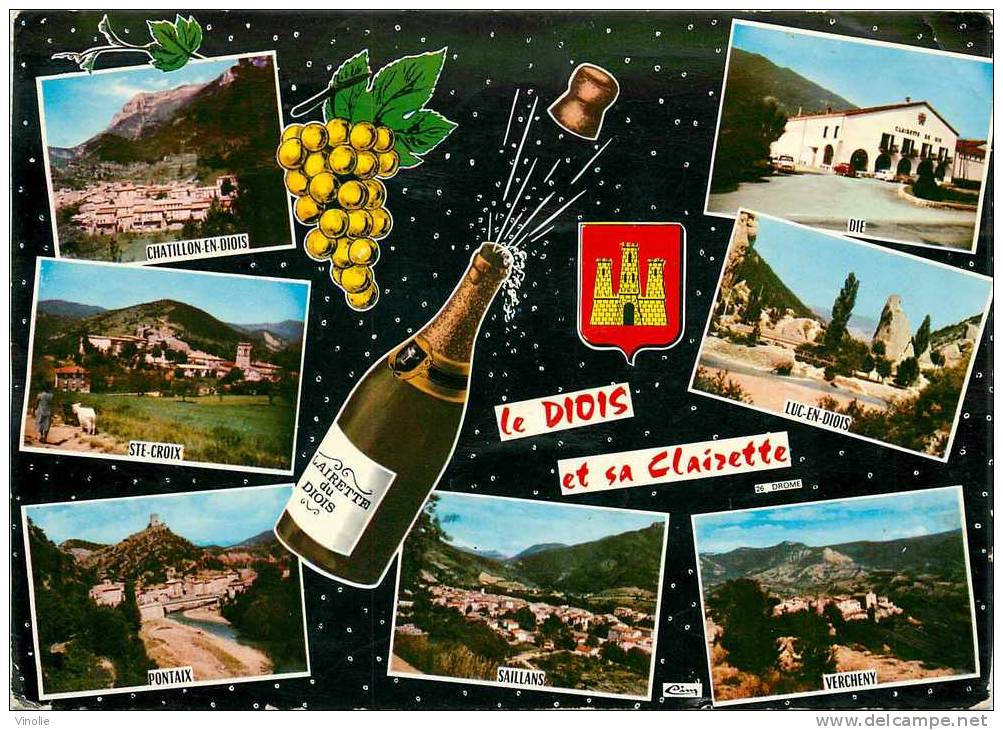Clairette de Die - the importance of direction
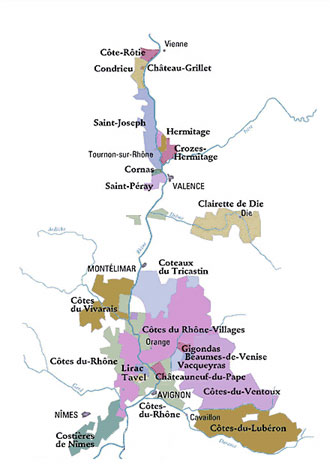 Legend says that the process to make the sparkling wines of Clairette de Die was found accidentally by a Gallo-Roman shepherd. He was using the cool waters of La Drôme river to chill a jar of local wine. The jar was forgotten and left in the cold water over the winter. Upon finding it in the spring, it was found to be carbonated, or pétillant, which roughly translates into English as "sparkling". Following the original discovery, Gallic tribes left jars of the wine in rivers over the winter and then recovered them in the spring.
The Diois vineyards are some of the highest in France (higher than most in Savoie for example), lying between 400 and 700 metres, rising as one travels eastwards. Saillans in the west stands at around 270m, the next village of Vercheny is at 350m, and Die itself at 415m, giving its name to the surrounding 'Diois' region. Some of the highest vineyards are beyond Die, at St Roman and Aix-en-Diois, over 600m, ripening usually about two weeks behind Saillans. Wine-making in villages upstream from St Roman is a challenge, with good grape maturity one year in five.
I have visited the Clairette de Die wine region three times. Once from the north, once from the south and once from the west. Each time my impression of the Diois region was strongly influenced by the route I took. Most accounts of the Diois are by those who come up from the Rhône; Clairette de Die wine is often described as being linked to the vineyards of the Rhône Valley.
Legend says that the process to make the sparkling wines of Clairette de Die was found accidentally by a Gallo-Roman shepherd. He was using the cool waters of La Drôme river to chill a jar of local wine. The jar was forgotten and left in the cold water over the winter. Upon finding it in the spring, it was found to be carbonated, or pétillant, which roughly translates into English as "sparkling". Following the original discovery, Gallic tribes left jars of the wine in rivers over the winter and then recovered them in the spring.
The Diois vineyards are some of the highest in France (higher than most in Savoie for example), lying between 400 and 700 metres, rising as one travels eastwards. Saillans in the west stands at around 270m, the next village of Vercheny is at 350m, and Die itself at 415m, giving its name to the surrounding 'Diois' region. Some of the highest vineyards are beyond Die, at St Roman and Aix-en-Diois, over 600m, ripening usually about two weeks behind Saillans. Wine-making in villages upstream from St Roman is a challenge, with good grape maturity one year in five.
I have visited the Clairette de Die wine region three times. Once from the north, once from the south and once from the west. Each time my impression of the Diois region was strongly influenced by the route I took. Most accounts of the Diois are by those who come up from the Rhône; Clairette de Die wine is often described as being linked to the vineyards of the Rhône Valley.
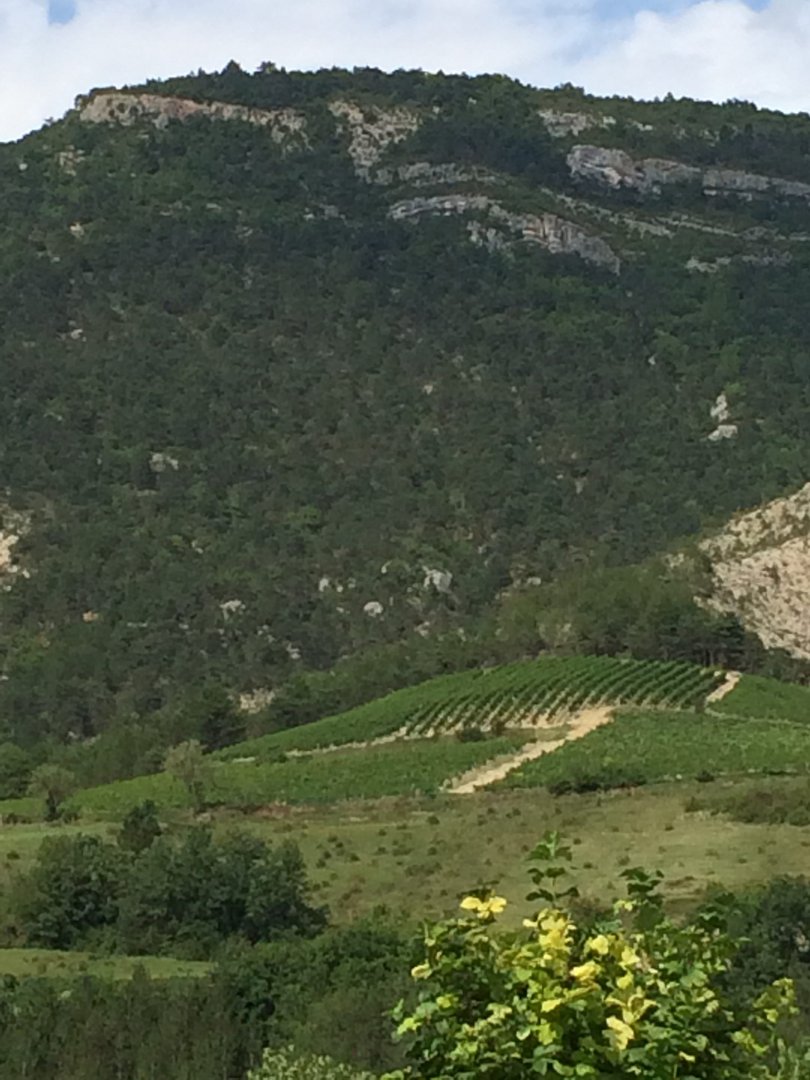
Alpine vineyards in the Diois For my first visit I came over the mountains from the high Vercors plateau in the north. I was 'enjoying' a cold, grey and wet honeymoon, and we went in search of sunshine. As soon as we crossed the mountain pass from the Vercors into the valley above Die, we entered into stunning sunshine, vines, fruit and nut orchards and what felt like Provence. We had an idyllic lunch on the terrace of a lovely restaurant before returning to the north. As if to confirm the sun-drenched location and the regions proximity to Provence and the Southern Rhône, the sparkling muscat Clairette de Die wines taste of sun-ripened fruit; sweet muscat wines were once the stars of the wine production of the south. Today the fortified muscats of Beaumes-de-Venise continue the tradition. The second time I came from the south, over the mountains from Nice, descending into the Drôme valley over the easy Col du Cabre from Aspres-sur-Buëch, climbing higher and higher into the mountains along the Buëch river, before coming down into the upper reaches of the upper Drôme valley. Scattered pockets of hillside vineyards, interspersed with mountain pines and over-looked by mountain peaks, slowly appear alongside the road as the route descends.. At this point, this feels alpine and is definitely NOT Provence. The first – south-eastern – vineyards are the highest in the region, surrounded by pastures and alpine pines. As one travels westwards down the valley, past Die, the climate becomes milder and the countryside more gentle. The road descends to the town of Die before turning westwards. The few red wines we tried confirmed this impression of the wines of the Diois were from northern, alpine vineyards. Light red, fresh acidity, moderate tannins.

Vineyards on the lower slopes The third time I came to the Diois from the northern Rhône vineyards of Cornas and St Peray, driving eastwards up the Drôme river valley. The western end of the region has a busy flow of traffic to and from the Rhône, the valley is wide and undulating. The vineyards lie over the rolling hills of the Drôme valley where villages, dominated by castles, look towards the prosperous Rhône valley. The nature of the valley changes as it passes through a small, narrow gorge into a wider valley around Die. From this direction, coming from the sparkling wine appellation of St Peray, Clairette de Die seemed like an extension of the same sparkling tradition. Yes, the red wines are lighter and more delicate, but the use of Syrah and Gamay points clearly to the Rhône Valley and Beaujolais. After a very brief visit to several vineyards, I came away feeling that this ambiguity over where Clairette de Die fits in geographically has not served the area well. The confusion is further emphasised by several appellations within one small area.
- Côteaux de Die AOP: 100% Clairette, still white wine.
- Chatillon-en-Diois AOP: Still white, rosé or red wines. White made from Chardonnay and Aligoté. Red and rosé made from Gamay, Pinot Noir and Syrah.
- Cremant de Die Brut AOP: Made primarily with the grape Clairette and some Muscat and Aligoté. It is a classic dry sparkling wine.
- Clairette de Die Tradition AOP: Made with a minimum of Muscat Blanc à Petits Grains and a maximum of 25% Clairette. Alcohol of 7.5% to 8.5%. 90% of production. Made using the méthode ancestrale with a single fermentation in bottle. The wine is then lightly filtered and transferred to another bottle. Some producers are now leaving the wine in the original bottle on the lees for a few months or is sold with the lees still present in the wine to give greater character.
- Clairette de Die Brut (might be a demi-sec as well?) made with a 2nd fermentation in bottle from 100% Clairette
- From 2016 Clairette de Die Rosé - see below.
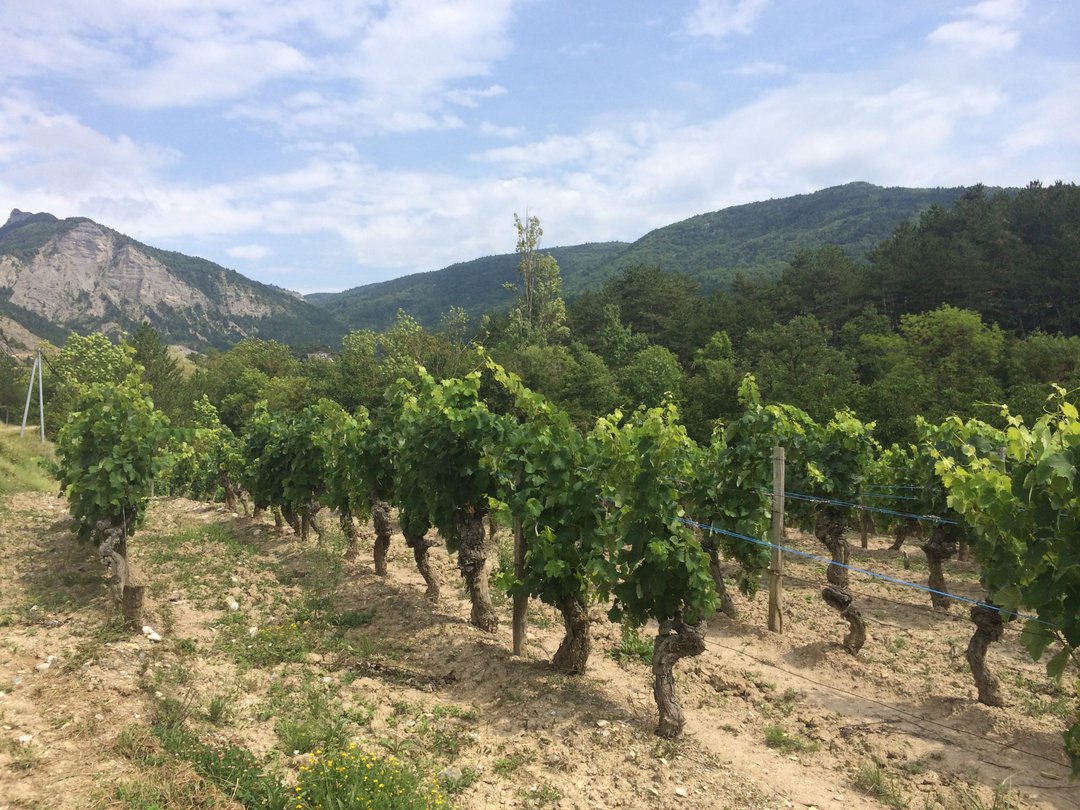 It is with Clairette de Die where this region shines. The basic Clairette de Die Tradition wines are fresh, sweet, grapey and fizzy. But, increasingly a number of producers are looking to make single vineyard, older-vine versions which reveal greater complexity of fresh fruit and terroir character - and these are certainly the wines to look out for.
I particularly liked the wines of Achard Vincent (imported into the UK by Yapp Bros). Their P'tit Gaby Clairette de Die (no SO₂), named after the best parcel/single vineyard wine, was full of elderflowers, lime leaf, fresh grapey fruit with hints of grapefruit peel. The Gabrielle de Richaud, Clairette de Die, 4-5 months sur lie, had more weight with hints of nuts and cream, peach and rich dried fruit and fresh, zesty acidity; both 100% Muscat Blanc à Petits Grains.
Domaine Monge-Granon also make some good more complex wines. Its Clairette de Die Pur Muscat, at 8% alc had greater intensity and richness than their basic wine, with fresh grape fruit and hints of spice, but with the same degree of sweetness and the same fresh acidity. Their Clairette de Die Cuvée de Minuit 100% Muscat Blanc à Petits Grains, was made from a single parcel of the best grapes creating a sweet, rich and most intense Muscat.
It is with Clairette de Die where this region shines. The basic Clairette de Die Tradition wines are fresh, sweet, grapey and fizzy. But, increasingly a number of producers are looking to make single vineyard, older-vine versions which reveal greater complexity of fresh fruit and terroir character - and these are certainly the wines to look out for.
I particularly liked the wines of Achard Vincent (imported into the UK by Yapp Bros). Their P'tit Gaby Clairette de Die (no SO₂), named after the best parcel/single vineyard wine, was full of elderflowers, lime leaf, fresh grapey fruit with hints of grapefruit peel. The Gabrielle de Richaud, Clairette de Die, 4-5 months sur lie, had more weight with hints of nuts and cream, peach and rich dried fruit and fresh, zesty acidity; both 100% Muscat Blanc à Petits Grains.
Domaine Monge-Granon also make some good more complex wines. Its Clairette de Die Pur Muscat, at 8% alc had greater intensity and richness than their basic wine, with fresh grape fruit and hints of spice, but with the same degree of sweetness and the same fresh acidity. Their Clairette de Die Cuvée de Minuit 100% Muscat Blanc à Petits Grains, was made from a single parcel of the best grapes creating a sweet, rich and most intense Muscat.
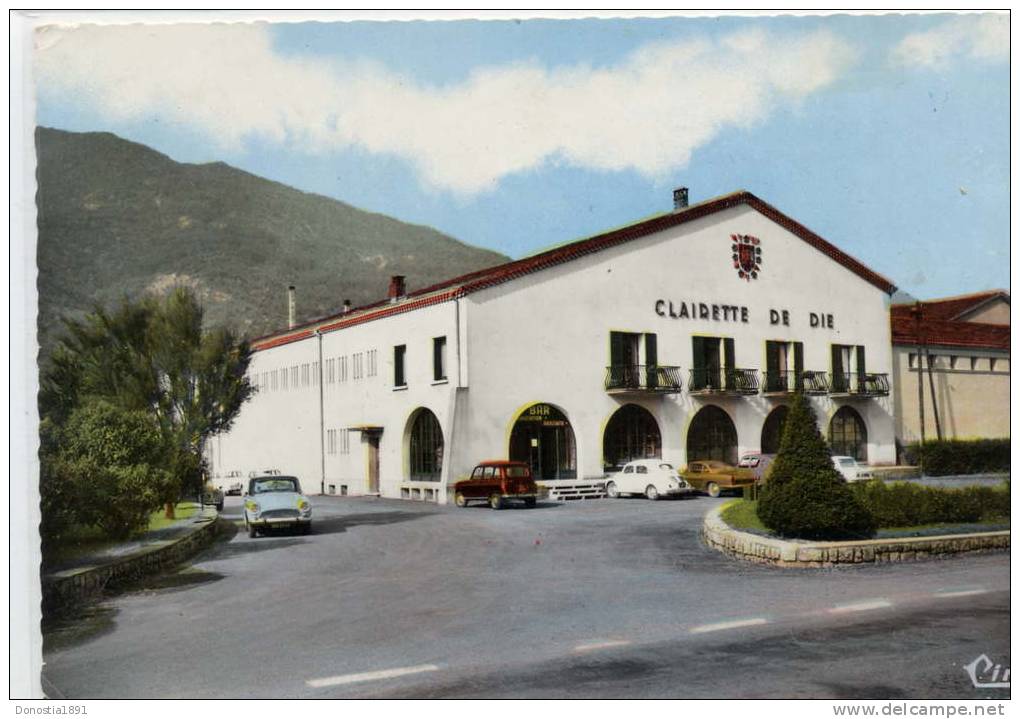
Old postcard of the Jaiillance co-operative
By far the biggest producer of Clairette de Die wine is the Jaillance cooperative, which counts as its members 80% of producers in the region and produces the most well known wines of the region. Some of their range are available through Nicolas in the UK. Jaillance have an impressive showroom in Die, whose ground floor (behind the arched windows in the picture) has been turned into a vast shop selling wine and gourmet food. At the far end is wine bar where you can can sample any of their wines.
Florence Chiumento, the Jaillance product manager, told me how Jaillance realised that the Clairette de Die appellation was the last sparkling wine appellation in France without a rosé wine, so they were keen to add one to the appellation. A few years ago, they had noticed that the fields of Muscat Blanc à Petits Grains grapes contained some vines which had mutated and were producing blacker grapes than usual, so they asked their producers to put these to one side, and experimented with producing a muscat rosé.
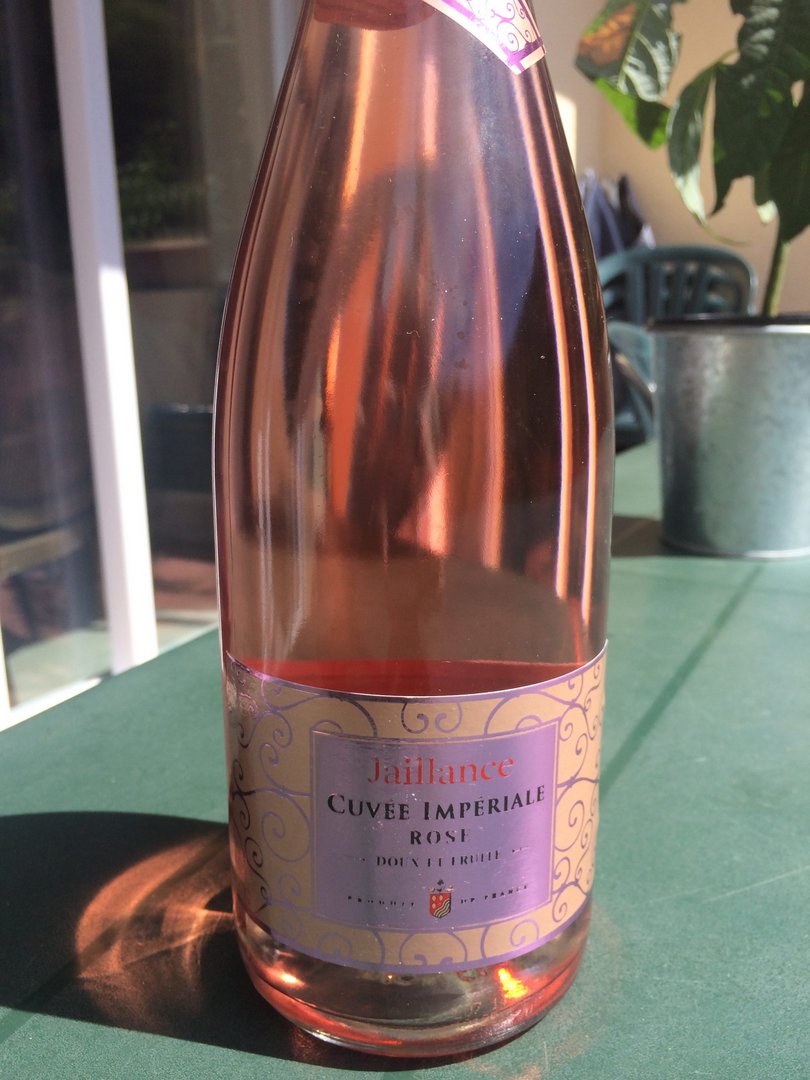 The first meeting to apply for the AOP status was in April 2013. The style of the wine was then discussed; aiming to be sweet, fruity with added aromas of the red fruit.and rosé - not dry and without adding red wine (as in Champagne). Made in same method as Clairette de Die. Work has been done on planting Muscat Rouge à Petits Grains, plus the clonal variants of the red Muscat Blanc à Petits Grains. The first wine with AOP status will be the 2015 vintage, on sale 2016. Grape varieties used will be Muscat Blanc à Petits Grains, Muscat Rouge à Petits Grains (mutation of Muscat Blanc à Petits Grains) and Gamay. The percentage in the blend of the three varieties will depend on each winemaker. So far trial wines only being made by Jaillance, Carod and the Union of Young Wine Producers (UJVR).
This gently sweet sparkling rosé combines the fresh floral grape character of the white Clairette de Die wines, with the added black fruit character from the Muscat Rouge à Petits Grains.
These lovely Muscat-based Clairette de Die sparkling wines remain a drink appreciated by a relatively small market. To me, they are the perfect wines to drink on a summer evening either as an aperitif or with a fruit-based or creamy dessert. Their lower alcohol makes them superb as at the end of a heavier meal. The wines do not carry indication of vintage, and are for drinking young, when fresh, floral and exuberant.
A growing awareness amongst producers of the potential quality of their appellation, which can stand alone without being tied to neighbouring regions, is evident in the move to produce a greater range of rich and complex sparkling muscat wines. And for those who want to explore the area, and not just drive through, the Clairette de Die Routes de Vins provides information on how to walk through the vineyards from cellar to cellar. The Clairette de Die website includes the list of producers.
The first meeting to apply for the AOP status was in April 2013. The style of the wine was then discussed; aiming to be sweet, fruity with added aromas of the red fruit.and rosé - not dry and without adding red wine (as in Champagne). Made in same method as Clairette de Die. Work has been done on planting Muscat Rouge à Petits Grains, plus the clonal variants of the red Muscat Blanc à Petits Grains. The first wine with AOP status will be the 2015 vintage, on sale 2016. Grape varieties used will be Muscat Blanc à Petits Grains, Muscat Rouge à Petits Grains (mutation of Muscat Blanc à Petits Grains) and Gamay. The percentage in the blend of the three varieties will depend on each winemaker. So far trial wines only being made by Jaillance, Carod and the Union of Young Wine Producers (UJVR).
This gently sweet sparkling rosé combines the fresh floral grape character of the white Clairette de Die wines, with the added black fruit character from the Muscat Rouge à Petits Grains.
These lovely Muscat-based Clairette de Die sparkling wines remain a drink appreciated by a relatively small market. To me, they are the perfect wines to drink on a summer evening either as an aperitif or with a fruit-based or creamy dessert. Their lower alcohol makes them superb as at the end of a heavier meal. The wines do not carry indication of vintage, and are for drinking young, when fresh, floral and exuberant.
A growing awareness amongst producers of the potential quality of their appellation, which can stand alone without being tied to neighbouring regions, is evident in the move to produce a greater range of rich and complex sparkling muscat wines. And for those who want to explore the area, and not just drive through, the Clairette de Die Routes de Vins provides information on how to walk through the vineyards from cellar to cellar. The Clairette de Die website includes the list of producers.
